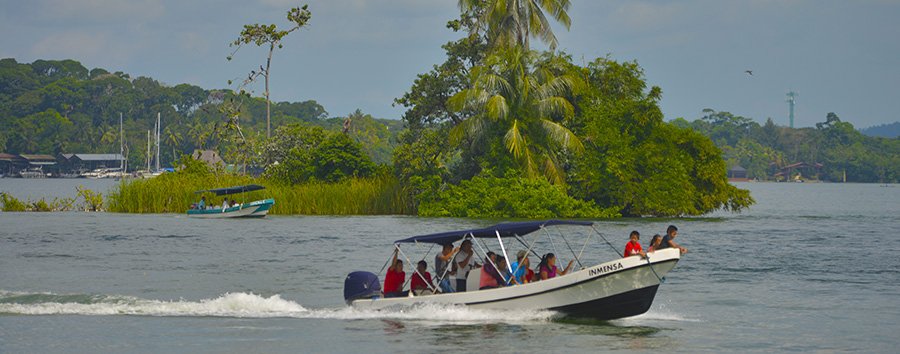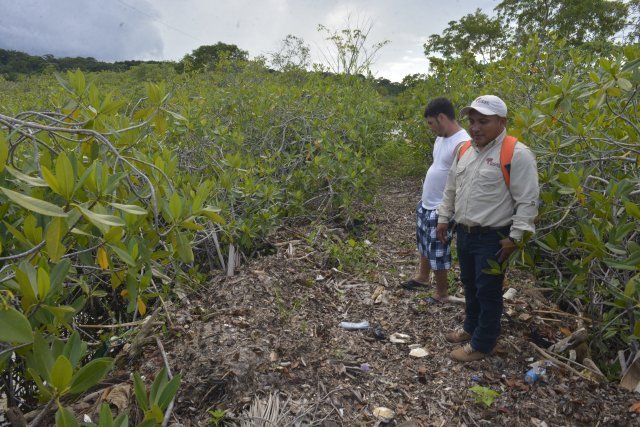Drugs, mining, monoculture threaten Guatemala’s mangrove ecosystems

According to Guatemala’s Center for Conservationist Studies (CECON), Lake Izabal’s famous “Bird Island” will soon disappear. Credit: Jesús Alfonso.
By Francelia Solano
Translation by Monica Santizo and Richard Brown
On Guatemala’s Caribbean coast, criminal activity is destroying mangroves and the livelihoods of families who depend on them. Yet Guatemala’s mangrove ecosystems are connected to those of Honduras, Belize and Mexico. What happens to one affects the others.
The mangroves to the left are damaged and divided, and their foliage is scarce. The mangroves to the right are thriving. The difference between them is a border; to the left is Guatemala, and to the right is Belize.
The trees seem to embrace each other as their interlaced branches grip the marshy terrain where land and water merge. These mangroves are key to the survival of Guatemala’s biggest lake, Lake Izabal, and therefore the local economy, 80% of which depends on the lake.
Though they are indispensable, the mangroves are being plundered in clear view of the authorities. Drug trafficking, mining and vast plantations of crops like African palm gag local residents who are afraid to speak out even though they see the livelihoods that have sustained their families for generations gradually disappearing.
1. Fishermen without fish
The boat leaps higher on choppy water at 2 am, when the López family goes to fish. In pitch-black darkness, they try their luck with fishing nets. On good days, they catch enough fish to feed the family. On bad days, they go home with nothing.
The López family has fished for generations. But water pollution, illegal shrimping and the destruction of the mangroves—where 80% of local marine life begins—have made it impossible for them to continue to live from fishing alone.
Cervando Eduah, from the town of Sarstún, agrees with the López family: fishing no longer provides a living. He explains that he has repeatedly reported the shrimping operations in Izabal.
The shrimping is aggressive, he says. They have nets that “look like strainers” and trap even the smallest species.
This kind of shrimping is illegal under Article 80 of Guatemala’s General Law on Fishing and Aquaculture [Ley General de Pesca y Acuicultura]. But the Office of Fisheries and Aquaculture Compliance at the Ministry of Agriculture, Livestock and Food (MAGA), doesn’t punish these aggressive practices even though they threaten fish populations. Nor are convictions or fines imposed for damaging the mangroves.
Oscar Santos, a biologist at CECON at Guatemala’s University of San Carlos, explains that marine life begins in the mangroves. The structure of this ecosystem prevents large species from entering and therefore encourages fish reproduction. Many species spend the first stage of their lives in the mangroves until they are large enough to venture out to sea.
So, the decline in fish here is alarming.

Illegal shrimping leaves local fishermen without fish / Credit: Jesús Alfonso
Santos says that illegal shrimping is aggressive. He also names another cause of the ecosystem’s deterioration: MAGA’s lack of interest in updating seasonal regulations that prohibit the fishing of certain species when they reproduce to prevent population declines.
The people of Barra Cocolí, a Guatemalan Caribbean community 45 minutes from Livingston, in Izabal province, are trying to change the situation.
A year ago, they started a tourism initiative with modest funds. This has helped them compensate for falling fishing incomes and also regain what they had lost: reliable fish stocks.
Through the initiative, they hope to reforest the mangrove that once existed in their community. But Fernando López, from Cocolí, says that reforesting mangroves isn’t easy. Fernando and Cocolí’s other 25 residents have taken many courses on the topic and still they haven’t succeeded.
The mangrove tree is difficult—and expensive—to grow because it requires trial and error; techniques that work in one area may not work in another.
Fernando López points out two PVC tubes embedded in the shoreline of the lake. A year ago, he recalls, the shoreline was full of tubes that contained mangrove tree seeds. Now, the two tubes are all that remain of their sizable investment.
The residents of Cocolí explain that they should have put more seeds in the tubes to increase the chance that some would take root and share nutrients with other sprouts. They also learned how to identify stable areas where the mangrove trees grow more easily.
2. Seventy percent of Guatemala’s mangroves have vanished
Since 1950, 70% of Guatemala’s mangroves have vanished, according to a 2009 Nature Conservancy study (“Marine Biodiversity of Guatemala”). This affects the communities that depend on them. Santos argues that most of the economy of the province of Izabal is based on its marine resources.
Another study (“Economic and Cultural Analysis of the Mangroves of the Guatemalan Caribbean” from 2017) by the Guatemalan Foundation for Development and Conservation (FUNDAECO) states that 83% of residents in Livingston and Río Sarstún say their incomes depend directly or indirectly on the mangroves. One hundred percent of those who fish believe their livelihoods depend on the mangroves’ health.
Further, the Guatemalan Caribbean is intimately connected to at least three other ecosystems: forests, seagrass beds, and the Mesoamerican Barrier Reef System (MAR). The MAR is the Atlantic Ocean’s biggest coral reef and stretches along the coasts of Mexico, Belize, Guatemala and Honduras. In its MAR Healthy Reef Report Card, the organization Healthy Reefs shows the alarming decline of Guatemala’s fish stocks. In just 10 years, Guatemala’s marine species have lost 75% of their population, leaving ecosystems extremely vulnerable.

Every year, Guatemala loses approximately 1% of its mangrove coverage / Credit: Jesús Alfonso
Guillermo Gálvez is a fish farmer, FUNDAECO investigator and mangrove monitoring officer in Río Sarstún. He says the conservation of these four ecosystems is interdependent. Each protects the others from natural disasters. For example, 100 meters of mangroves can decrease the force of a tsunami up to 90%. Mangroves therefore protect not only inland forests but also nearby communities.
3. The destruction of a natural barrier
In addition to mitigating tsunamis, the mangrove ecosystem also prevents coastal erosion.
Mangrove trees filter air better than any other tree species. The mangroves also filter the water that enters the ecosystem and are a refuge and safe birthplace for more than 80% of the region’s aquatic species.
Despite the importance of this key ecosystem, the local governments of Livingston and Puerto Barrios have no plans to protect it. Nómada reached out to both mayors, but neither agreed to an interview.

Along rivers, mangroves act as natural water filters / Credit: Jesús Alfonso
The threats to the mangroves include clearcutting for the construction of tourist destinations, some of which have even been built in protected areas.
The director of the Office of Government Monitoring of Protected Areas (OCRET) in Izabal says that it is not OCRET’s responsibility to monitor what people do in areas they lease from the government. He adds that OCRET studies only potential impacts during the permitting process, and that they cannot follow up to monitor how these lands are used once they are leased.
4. Searching for a regional mangrove strategy
The mangrove ecosystem and the MAR stretch together along the coasts of Mexico, Belize, Guatemala and Honduras. What happens to one can impact the other. Now, governments and environmental organizations from these countries seek to communicate, like their ecosystems, through a Regional Strategy for Conservation and Restoration of Mesoamerican Reef Mangroves. A working group was formed a year ago.
To outline the regional strategy, 69 experts from the four countries gathered for three days, from September 18-20, in Guatemala City. After speeches and discussions, they began the process of crafting proposals. Next year, they hope to announce first steps to begin to guide the policies of the four countries.
Marine biologist Steven Canty, the coordinator of the Smithsonian Institution’s Marine Conservation Program and coordinator of the strategy, told Nómada that this was a space for dialogue, but also to share experiences about what each country is doing to protect its mangroves. This exchange of knowledge can lead each country to adopt new measures and adapt them to its context, he added.
Anaité López, ecosystems director of Guatemala’s National Forest Institute (INAB), explains that during the event it became clear that Mexico has better mangrove restoration strategies than Guatemala. Still, she adds that Guatemala has a better legal framework through its Regulation for the Sustainable Management of Mangrove Ecosystem Forest Resources.
5. Drug trafficking, mining and plantations
Canty says that Guatemala’s mangroves face various threats. The first is from the massive quantity of chemical products used in agriculture. Pedro Julio García, the coordinator of the Hydrology Research Institute at the University of San Carlos, explains that rain washes pesticides from the soil into Lake Izabal and nearby rivers where they reach the mangroves.
Mangrove roots serve as water purifiers and begin to filter the pesticides, but when the quantity is so large, the roots eventually reach capacity and fail as filters. Other ecosystems, among them coral reefs that rely on mangroves to provide clean water, are left vulnerable.
This is where agribusiness plantation companies—like the African palm grower Naturaceites and the banana grower Del Monte—come in. Their aggressive monoculture planting techniques affect water quality and consume land. García explains that monoculture plantations tend to expand row by row, often reaching mangroves.
Mining also affects the mangroves, especially the operations of the Guatemalan Nickel Company (CGN). The last major water study in the region, carried out 10 years ago by the University of San Carlos, found a strong presence of heavy metals in the water. The most aggressive: lead. An environmental researcher in the region, who asked to remain anonymous, added that the only source of this type of metal is the CGN mine.
Nomada sent emails to Naturaceites, Del Monte and CGN requesting interviews, but none of them responded.
Maritza Aguirre, the director of the Authority for the Sustainable Management of the Lake Izabal and Río Dulce Watershed (AMASURLI), says that they have no recent studies examining heavy metals in the water. To conduct this kind of study, she explains, AMASURLI would require specialized staff and more funding.
Pedro Julio García, of Guatemala’s Ocean and Aquaculture Research Center (OARC) at the University of San Carlos, says that lead has also been found in marine animals in varying concentrations depending on the species. He explains that in the marine food chain bigger fish tend to have higher concentrations of these heavy metals, and some of these bigger fish are part of our diet. In other words, our food may contain low doses of “poison.”
According to the World Health Organization (WHO), lead that accumulates in the body causes progressive damage. There is no harmless level of lead; in doses high or low, lead can do serious harm. The WHO considers it a poison.
The third most significant problem is livestock. Livestock farmers in the region often cut channels through wetlands or marshy areas. These channels draw in the wetlands’ water, and the land gradually dries up enough to grow grass. After two years, the farmers have new pasture on which to graze their cattle.
Two people with knowledge of the topic who asked to remain anonymous, indicate that these practices are intimately tied to drug money laundering. In separate interviews, both asserted that drug traffickers have enormous influence in the area. For example, police recently impounded a construction excavator that was digging a wetland channel. After just three days, it was returned to its owner after he paid a Q3,000 (US$390) fine.

Illegal channels are like artificial rivers that dry out wetlands that are later used as pasture for livestock / Credit: Jesús Alfonso
The two sources agree that if a study were conducted on the impact of these practices, the losses would be assessed at Q10,000 or more. However, government agencies, NGOs and local residents have their hands tied due to the inaction of local government authorities.
Mario Lemus, OCRET’s director, acknowledges the difficulties faced by these three groups. Referring to the National Council of Protected Areas (CONAP, Consejo Nacional de Áreas Protegidas), he said: “The truth is that, yes, those poor CONAP people… they can’t report anything because of the drug trafficking.”
6. A trail of plastic
Every morning after fishing, the López family goes to a little, white sand beach. At this hour, the sand isn’t completely white because it’s littered with all kinds of trash: glass bottles, baby bottles, packaging, polystyrene, plastic bags, and a vast array of other plastic waste.
Sometimes they fill huge sacks full of trash. The trash is everywhere: floating between mangrove roots, in the water, in the sand.
The López family puts the trash they collect toward building a pathway made from plastic that offers views of huge swaths of Rhizophora mangle, or red mangrove trees. The red mangrove trees here are special for their short stature caused by a lack of phosphorus in the area.

The López family built a trail through the mangroves with the trash they find every morning / Credit: Jesús Alfonso
The trail is approximately 30 centimeters wide and 10 meters long, made of six months’ worth of plastic. Where does that plastic come from? From everywhere. Some labels are in English. Some say “Made in Belize,” or Mexico, Honduras or Guatemala. The water systems of these four countries are connected.
Pedro Julio García, the researcher, said that the University of San Carlos is conducting a water assessment project. Initial samples have yielded a significant quantity of phthalates in Lake Izabal. Phthalates are found primarily in soft plastics, like baby bottle nipples, food packaging and thin plastic bottles.
This presence of this chemical group affects local residents directly as they regularly consume and come into contact with the water. In a study published in Environmental Science & Technology, researchers found that miscarriages were correlated with the presence of phthalates in women’s urine, and that phthalates in men’s urine have been linked to testicular cancer and low sperm counts.
The lack of in-depth water quality studies, the lack of a national water law that standardizes regulations, and the lack of commitment from local governments that border Lake Izabal may soon lead the lake to a point of no return, says García.
Oscar Santos, who monitors Lake Izabal’s water, explains that the lake is very unhealthy. He says that if problems like plastic, water pollution, and the spread of the invasive hydrilla plant are not dealt with soon, the ecosystems that depend on the lake, like mangroves and coral reefs, will be at risk.
Santos concludes that in 10 years the lake could be “as affected as Lake Amatitlán” and that the damage would be almost irreversible.
7. Weak punishments
Seated behind her desk, the Environmental Crimes Prosecutor of Guatemala City, Aura Marina López, signs papers in a hurry. Workers arrive with folders in their hands to ask her about certain cases. She hastily explains that when the Public Ministry (MP) receives a complaint, it handles any cases that result.
López says that the environmental crimes office lacks the resources necessary to adequately investigate environmental crimes, especially those that occur in the mangroves. She says that they investigate only when they receive complaints. When asked how many convictions for crimes in the mangroves they have achieved in the last five years, she answers with confidence.
None.
On the other side of the office someone says, “No, there was one conviction.” It was a case involving the Salamanca Plantation in Escuintla. It ended in a fine of Q20,000 and a requirement that the guilty party pay for Q5 million worth of trees, though they won’t be mangrove trees. López says mangroves regrow naturally, but experts explain that mangrove regrowth is complex and requires care and expertise.

The Belize side of the Sarstún River is better preserved / Credit: Jesús Alfonso
The MP’s public records reveal 330 investigations of protected species infractions since 2009, but they do not specify which species were involved. Only six resulted in a conviction.
In two cases, the accused were sentenced to five years in jail, a fine of Q20,000 (US$2,600) and expulsion from the country. Two other cases resulted in 10 days in jail, one fine of Q500, and another of Q1,000. The last two resulted only in fines of Q2,000 and Q3,000.
The Environmental Crimes Prosecutor’s Office blames CONAP, OCRET, DICRI and DRIPRONA for their poor performance. Hendryc Acevedo, the director of CONAP in Izabal, shows off a list of 60 complaints filed by his branch of CONAP. Of the 60, 57 have been closed without conviction and three remain under investigation.
In Belize, only a few meters past the Sarstún River, things are different. If authorities detain anyone damaging the mangrove ecosystem, they face up to 20 years in jail and fines of up to US$100,000.
Belize punishes harm to the mangroves, but Guatemala rewards it.
This story was originally published in Spanish in Nomada on 2 Jan. 2020. It was produced with support from the Earth Journalism Network’s Mesoamerican Reef Reporting project.
The English version was published here and here.





